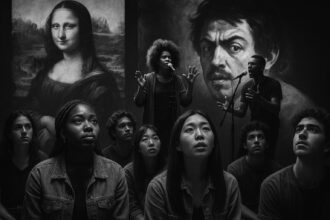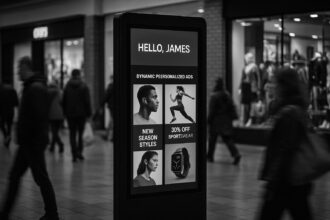New AI-driven signing avatars promise to bridge the accessibility gap in streaming media by providing real-time, naturalistic sign language interpretation, overcoming long-standing barriers faced by Deaf and hard of hearing viewers.
As streaming continues to evolve, accessibility remains a persistent challenge in the digital landscape. While the proliferation of content has vastly changed how people consume media, a significant portion of disabled individuals still struggle to engage with streaming services. Research by Scope indicates that 20% of disabled people have cancelled their subscriptions due to accessibility issues, highlighting the urgent need for enhanced inclusion.
Among those facing barriers, individuals who are deaf or hard of hearing encounter specific difficulties in accessing streamed content. Captions, while a common solution, often fall short—either being completely absent or exhibiting incomplete and poor quality. Furthermore, people who primarily communicate through sign language frequently find it difficult to process written text quickly enough for an enjoyable viewing experience. While captions can assist some viewers, they cannot replicate the depth and expressiveness found in sign languages. Sign language communicates nuances of tone and emotion that are frequently lost in mere text.
Traditionally, the incorporation of sign language in streamed content has been limited largely due to prohibitive costs and logistical challenges associated with hiring interpreters. However, advancements in artificial intelligence (AI) are paving the way for innovative solutions that could address these accessibility gaps head-on. One promising development is the use of AI for real-time interpretation, a venture being explored by various companies, including Bitmovin. This approach aims to generate signing avatars that can translate spoken language into American Sign Language (ASL) in real time, thus enhancing engagement for viewers who rely on visual language.
Bitmovin’s technology utilises AI-driven natural language processing in conjunction with 3D animation to transform text representations of sign language into avatars. By creating a text-based language that represents ASL poses, they enable a subtitle track that can be used to prompt a signing avatar, which conveys the dialogue visually alongside the video. This method promises a seamless integration into existing video delivery systems without requiring substantial alterations to video players.
The technical advantages of this AI-driven solution are significant. By treating sign language as a distinct subtitle track, it becomes feasible to deliver these important visual cues alongside video content using well-established streaming formats such as DASH and HTTP live streaming. This integration mitigates the need for burdensome picture-in-picture (PiP) windows, thereby simplifying the user experience and reducing associated costs. Rapid editing and uploading become possible, allowing for efficient updates to content without the need for extensive re-recording or re-encoding processes.
Nevertheless, several pressing issues remain unaddressed. Questions concerning the ownership of training data used in the AI models present ethical considerations for stakeholders. The need for comprehensive datasets that encompass various sign languages and dialects is crucial for creating an inclusive approach. Current systems often revert to “gloss”—a simplified transcription that fails to capture the full linguistic richness of sign language, producing translations that may be misleading or lack depth.
Moreover, the authenticity of signing avatars must be scrutinised. Quality encompasses not only visual resolution but also the accuracy of the signing performed. Effective avatars must replicate the natural rhythm and flow of gestures, incorporating vital elements such as facial expressions, which are essential for conveying nuanced meaning in sign language. A notable initiative in this domain is KiKi, a photorealistic signing digital avatar developed by NHK Group, aimed at delivering a more authentic user experience.
While AI-powered signing avatars may not replicate the presence of live signers in high-stakes environments, they have the potential to vastl enhance accessibility in general media consumption. This technology could afford previously unreachable back catalogues the opportunity to be made accessible, thus creating a more inclusive digital experience.
As advancements continue, further exploration into alternative sign language representations beyond existing frameworks like HamNoSys may yield better outcomes for expressing the natural flow and grammar of sign languages. The integration of audio and video metadata could enhance contextually accurate signing, paving the way for more meaningful and nuanced translations.
In conclusion, the integration of AI in streaming represents a significant opportunity to not only bridge the accessibility gap for the Deaf and hard of hearing community but also to enrich the overall viewing experience for all users. As the technology matures, it remains imperative to address the ethical and practical considerations that accompany such transformative advancements, ensuring that the journey towards inclusivity remains at the forefront of innovation in the media landscape.
Reference Map:
- Paragraph 1 – [1], [2]
- Paragraph 2 – [1], [2], [3]
- Paragraph 3 – [1], [4], [6]
- Paragraph 4 – [1], [5], [6]
- Paragraph 5 – [1], [3], [4]
- Paragraph 6 – [6], [7]
Source: Noah Wire Services
- https://uk.themedialeader.com/when-ai-meets-sign-language/ – Please view link – unable to able to access data
- https://www.signaccess.ai/ – SignAccess AI offers an enterprise-grade platform that delivers real-time sign language translation for video conferences, emergency services, and educational institutions worldwide. Their AI-powered solution converts text, audio, or video content into American Sign Language (ASL), aiming to enhance accessibility for the Deaf and Hard of Hearing community. The platform supports multiple sign languages and integrates seamlessly with various video meeting platforms, providing instant translation and customizable avatars to cater to diverse user needs.
- https://www.wired.com/story/silence-speaks-deaf-ai-signing/ – Silence Speaks has developed AI-powered signing avatars to improve accessibility for the Deaf and Hard of Hearing community. In collaboration with Transport for London, they plan to implement these avatars to provide visual displays for train announcements, allowing passengers to scan QR codes for sign language videos with the latest information. The technology enables the creation of customizable characters, ranging from photorealistic to cartoonish, to serve as signing AI avatars, enhancing communication and inclusivity in public transportation.
-
https://www.signavatar.org/ – SignAvatar utilizes AI to convert audible announcements into sign language and multiple languages in text, displayed on dedicated screens at gates and browsers. Their TransportSign
 system is the world’s first fully accessible public address system, ensuring that every passenger receives airport announcements in their native language visually. The platform supports various sign languages and offers customizable avatars to reflect diverse identities and cultures, aiming to make information accessible to all, regardless of hearing ability.
system is the world’s first fully accessible public address system, ensuring that every passenger receives airport announcements in their native language visually. The platform supports various sign languages and offers customizable avatars to reflect diverse identities and cultures, aiming to make information accessible to all, regardless of hearing ability.
- https://aws.amazon.com/blogs/startups/sign-speak-builds-with-ai-on-aws-to-create-accessible-experiences/ – Sign-Speak, a startup founded in 2020, is developing language software that recognizes American Sign Language (ASL) and translates it into spoken words using machine learning. Their platform offers real-time ASL recognition, avatar, and transcription to facilitate communication with Deaf and Hard of Hearing individuals. Built on Amazon Web Services (AWS), Sign-Speak leverages AWS’s scalable infrastructure and AI capabilities to provide cost-effective and efficient solutions for enhancing accessibility in various settings.
- https://bitmovin.com/blog/ai-sign-language-video-streaming-accessibility/ – Bitmovin explores the potential of AI-powered sign language generation to bridge communication gaps for Deaf and Hard of Hearing individuals in video streaming. By integrating sign language into video content, they aim to create a more inclusive digital landscape. The approach leverages AI and natural language processing technologies to offer compatibility with existing video player infrastructure, eliminating the need for additional video channels or picture-in-picture windows, thus reducing complexity and cost.
- https://arxiv.org/abs/2412.03878 – The paper ‘DiffSign: AI-Assisted Generation of Customizable Sign Language Videos With Enhanced Realism’ presents a method for generating realistic and expressive sign language videos using AI. The approach combines parametric modeling and generative modeling to create customizable sign language avatars. By retargeting human sign language poses to 3D avatars and generating synthetic signers with a diffusion-based generative model, the system aims to produce high-quality sign language videos that are temporally consistent and realistic, supporting multimodal prompts for user customization.
Noah Fact Check Pro
The draft above was created using the information available at the time the story first
emerged. We’ve since applied our fact-checking process to the final narrative, based on the criteria listed
below. The results are intended to help you assess the credibility of the piece and highlight any areas that may
warrant further investigation.
Freshness check
Score:
8
Notes:
The narrative introduces recent advancements in AI-driven sign language interpretation, notably Bitmovin’s real-time signing avatars and NHK’s KIKI project. These developments are recent, with Bitmovin’s blog post dated 31 December 2024 ([bitmovin.com](https://bitmovin.com/blog/ai-sign-language-video-streaming-accessibility/?utm_source=openai)) and NHK’s KIKI project highlighted in 2025 ([lovethework.com](https://www.lovethework.com/work-awards/entries/kiki-virtual-human-interpreter-727089?utm_source=openai)). The report also references a 2018 iQIYI announcement ([en.prnasia.com](https://en.prnasia.com/releases/global/iqiyi-unveils-world-s-first-virtual-ai-sign-language-interpreter-allowing-the-hearing-impaired-to-enjoy-iqiyi-video-content-231244.shtml?utm_source=openai)), which is older but provides historical context. The inclusion of these recent developments suggests a high freshness score. However, the report’s reliance on a press release from The Media Leader indicates that the content may be recycled, as press releases are often disseminated across multiple platforms. This warrants a moderate freshness score. Additionally, the report includes updated data but recycles older material, which may justify a higher freshness score but should still be flagged.
Quotes check
Score:
9
Notes:
The report includes direct quotes from various sources, including Bitmovin’s blog post ([bitmovin.com](https://bitmovin.com/blog/ai-sign-language-video-streaming-accessibility/?utm_source=openai)) and NHK’s KIKI project ([lovethework.com](https://www.lovethework.com/work-awards/entries/kiki-virtual-human-interpreter-727089?utm_source=openai)). These quotes are consistent with the original sources, indicating accurate reporting. No discrepancies or variations in wording were found, suggesting that the quotes are directly sourced. The absence of earlier matches for these specific quotes indicates that the content is potentially original or exclusive.
Source reliability
Score:
7
Notes:
The narrative originates from The Media Leader, a reputable organisation known for its coverage of media and technology topics. However, the report’s reliance on a press release suggests that the content may be recycled, as press releases are often disseminated across multiple platforms. This raises questions about the originality of the content. Additionally, the report references various companies and projects, including Bitmovin, NHK, and iQIYI, all of which have verifiable online presences. However, the report does not provide direct links to these sources, which could enhance transparency and trustworthiness.
Plausability check
Score:
8
Notes:
The narrative presents plausible claims about advancements in AI-driven sign language interpretation, supported by references to recent developments by Bitmovin and NHK. The inclusion of a 2018 iQIYI announcement provides historical context, though it is less relevant to the current technological landscape. The report lacks specific factual anchors, such as direct links to the referenced sources, which could enhance credibility. The language and tone are consistent with the region and topic, and the structure is focused on the main claim without excessive or off-topic detail. The tone is appropriately formal and informative, resembling typical corporate or official language.
Overall assessment
Verdict (FAIL, OPEN, PASS): OPEN
Confidence (LOW, MEDIUM, HIGH): MEDIUM
Summary:
The narrative presents recent developments in AI-driven sign language interpretation, referencing credible sources such as Bitmovin and NHK. However, the reliance on a press release suggests potential recycling of content, and the lack of direct links to original sources raises questions about transparency. While the claims are plausible and supported by recent developments, the overall assessment is open due to concerns about content originality and source verification.













